Cargo is at the forefront of urban air mobility. Emma Kelly investigates the sector and considers what it can teach vertiport developers
An aerial transportation revolution is under way, with drone deliveries of air cargo operating in rural and urban settings worldwide and passenger transportation by electronic vertical take-off and landing (eVTOL) aircraft set to follow.
While the ground infrastructure for cargo drone operations is much simpler and very different to the vertiport infrastructure required for safe and efficient passenger transportation, drone delivery services are providing valuable learning for their passenger counterparts of the not-too-distant future.
International management consulting firm Roland Berger, which has tracked the urban air mobility (UAM) sector since its beginnings, said determining the exact number of companies operating drone cargo delivery services is difficult as it is rapidly evolving. Principal Stephen Baur believes it is well above 300. “The drone delivery/cargo drone sector is expected to experience substantial growth in the next five years, driven by increasing adoption, advancements in technology and supportive regulatory frameworks,” he told Airports International. Roland Berger points to growth from $534m in 2022 to $17.9bn by 2030, fuelled by the rise in demand for on-site, on-time industrial delivery and emergency supplies and developments in the regulatory framework that will enable the operation of autonomous drones beyond visual line of sight (BVLOS).
Setting the standard
Ground infrastructure for drone services, if required at all, is often purpose-built and lean and efficient at the main hub of the drone operator, according to Baur. “Most concepts, however, require no specific infrastructure requirements at the customer or destination site,” he said. “We might see in the future, vertiport-type facilities, especially if potential cargo delivery and passenger services are operated from one hub,” he added.
Drone delivery operations serve as a blueprint for exploring efficient vertiport concepts
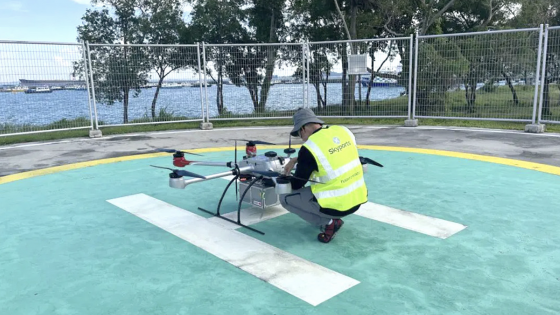
In 2019, Skyports launched the first passenger vertiport prototype, in Singapore
Cargo drone delivery services are providing valuable lessons for the future. “First, they serve as the foundation for building public acceptance, providing a clear use case and benefit to the customers and demonstrating reliable and safe operations,” Baur explained. Secondly, they are a testbed for exploring ways to integrate drones into the airspace and updating the regulatory framework accordingly. “Drone delivery operations serve also as a potential blueprint for exploring efficient vertiport concepts in terms of the most effective operational concept,” he added.
Duncan Walker, chief executive officer of vertiport developer Skyports, agrees. Writing in a Roland Berger blog last year, Walker said: “Cargo drones and early applications in cargo and mail transportation are a great opportunity to learn and gain experience from real-life data, BVLOS operations and public acceptance of drones.” The learning can be applied to passenger use cases, particularly in security, air traffic control, situational awareness and flight management.
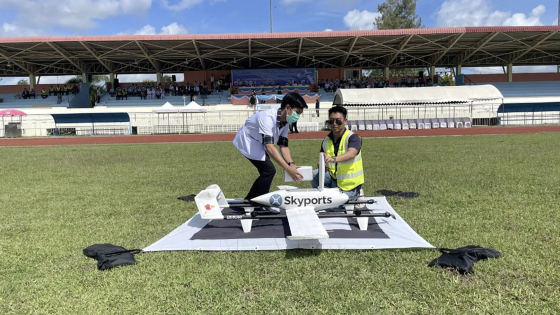
Skyports undertakes a medical drone delivery demonstration in Thailand
Skyports partnered eVTOL operator Volocopter and in 2019 launched the first passenger vertiport prototype, in Singapore, and is set to commercially launch a vertiport there next year. It has a European testbed vertiport at Groupe ADP’s Pontoise-Cormeilles Aerodrome, 16 miles northwest of Paris, where it is evaluating vehicle integration, flight scheduling, critical technologies and the passenger journey, with services planned for the 2024 Paris Olympic Games. At Skyports London Heliport, one of two London heliports it owns, it is testing technologies and procedures in an urban environment.
Skyports also has a dedicated cargo drone business, providing real-world operational experience. The division recently conducted a proof-of-concept for medical drone deliveries in Kaga City, Japan, as well as a medical drone delivery demonstration in Thailand.
Orkney operations
In late July, Skyports Drone Services launched the Orkney I-Port operation, a fully electric drone logistics project in partnership with the UK Royal Mail, Orkney Islands Council Harbour Authority and regional airline Loganair in the Orkney Islands, north of mainland Scotland. Drones are conducting daily inter-port delivery of Royal Mail items and demonstrating shore-to-ship deliveries. Previously, postal deliveries arrived from the Scottish mainland to Kirkwall Airport via Loganair and were then delivered to residents on Orkney’s main island or transported to one of the other 19 inhabited islands via ferry or small passenger aircraft, with the service subject to delays due to harsh weather.
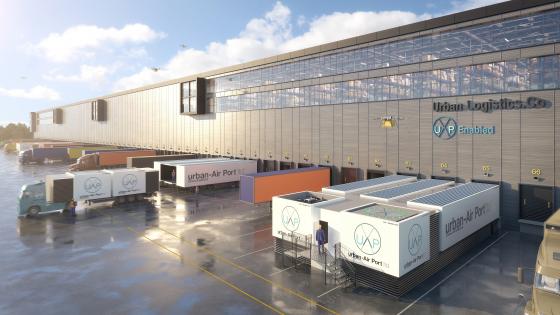
Docks Box is designed to integrate with existing logistics networks to add urban air mobility to the supply chain
Under the Orkney I-Port operation, Skyports Drone Services plans to run a daily inter-island mail distribution service, initially operating between three locations across Orkney for three months. Post is delivered by ground transportation from Kirkwall to a hub at Stromness from where it is transported by drone to Royal Mail sites on Graemsay and the North of Hoy, from where postal workers carry out their usual island delivery route. At the same time, Skyports Drone Services is conducting a feasibility study in partnership with Loganair on the potential for heavy payload operations in Orkney.
When it comes to vertiports in an urban setting, Walker said its design takes in a 40-year time horizon, supporting all operations. “While the basic requirements of the physical infrastructure are very similar for cargo and passenger use cases, there are some operational differences that need to be considered,” he said. “We are currently adjusting our vertiports to be able to accommodate autonomous operations and an overall efficient, lean set-up enabling high throughput of cargo goods and ground accessibility for further distribution,” he added. “The goods need to go the shortest way possible from the flight deck to the ground level, where the transfer to ground-based transport occurs.”
Australian company Skyportz expects to see separate development of infrastructure for cargo and passenger UAM activities for the time being, but convergence will happen once we reach the stage of pilotless, autonomous air taxis. Skyportz has vertiport designs and property partner locations ready to activate all over Australia when advanced air mobility (AAM) becomes a reality. It recently unveiled the design of its Vertiport-in-a-Box, which is an affordable, modular and turnkey solution for smaller property sites wanting to be involved in AAM.
“We have well over 500 sites in Australia and we are now accepting expressions of interest from property partners anywhere in the world,” said CEO Clem Newton-Brown. One of its partners is Australian property developer Pelligra, which is keen to develop vertiport networks to attract both air taxi and drone delivery services.
“While there will certainly be scope for some crossover, I expect that we will see vertiports for air taxis developing separately to cargo vertiports,” said Newton-Brown. “With drone delivery there are all sorts of logistics issues that are different and also they can deliver to places that an air taxi will never go,” he explained. Newton-Brown adds that industrial and commercial land in the future could potentially host a passenger vertiport as well as a drone delivery port, although they will most likely operate as separate entities.
Last-mile deliveries
Cargo drone operators worldwide are already providing hub-to-hub warehouse deliveries, last-mile supply chain deliveries, truck and ship loading and offloading.
Google’s Wing, for example, has been successfully operating last-mile deliveries in locations in Australia, the US and Finland for some years.
The service has been particularly well received in Australia where it operates from three locations in Southeast Queensland. Over four years, Wing Australia has delivered hundreds of thousands of packages, primarily groceries, Jesse Suskin, head of government relations and public policy, told an Australian Association for Uncrewed Systems conference in June. The service originally operated from warehouses, but the drones are now operating directly from Wing’s merchant partners’ premises – store-to-door. Wing has worked closely with Australian regulator the Civil Aviation Safety Authority to build up the capability and gain public acceptance along the way.

The recently unveiled Vertiport-in-a-Box from Skyportz is a modular, turnkey solution for smaller spaces
The ground infrastructure varies depending on the location, with Wing working closely with retail property groups to explore ways of getting the best value for their space. This includes a partnership in 2021 with Vicinity Centres to pilot a rooftop co-located operation at the Grand Plaza shopping centre in Logan, Queensland, delivering goods from a range of businesses located in the centre from its rooftop directly to customers. Wing has subsequently partnered with Mirvac to transform under-utilised retail real estate into on-demand drone delivery fulfilment hubs.
Despite requiring different infrastructure, there are valuable learnings its experience can offer passenger mobility stakeholders, said Wing, pointing to “building technology that can weather a range of different environments and temperatures. [It’s] about working closely with communities and regulators in the various jurisdictions where we operate and how customer demand for particular products varies across each of our service areas”.
Wing said it is always exploring expansion opportunities. “Drone delivery is a highly regulated industry and we work closely with regulators, state policymakers and local governments before expanding service to any new areas,” said Wing.
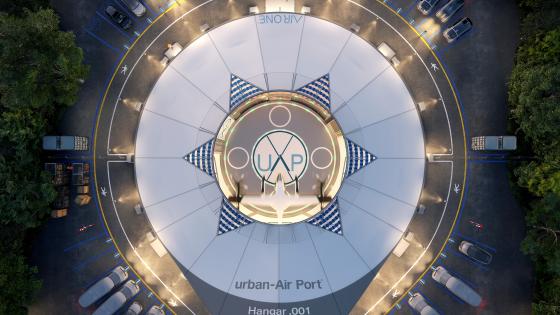
UAP will develop more than 200 vertiports over the next five years
Before launching in any new community, Wing has conversations with government officials, business and civic leaders, community organisations and groups to evaluate local needs and address any concerns, such as noise, with Wing using community feedback to improve its drone design so it emits a quieter, lower pitched sound.
Swoop Aero’s drones, meanwhile, have made more than 26,000 flights since 2020, carrying 1.4 million items, primarily medical supplies. It has operational approval in 14 countries, including within Africa, as well as Australia and New Zealand. In New Zealand, it recently launched an integrated drone logistics network in partnership with Te Whatu Ora Health New Zealand, transporting pathology samples and blood products. In Brisbane, Australia, it will shortly add operations carrying pathology samples from the Moreton Bay Islands to Mater Pathology for testing, having been delivering prescriptions to remote patients in Goondiwindi, Queensland since 2021.
In Canada, Drone Delivery Canada (DDC) is operating drone delivery services at Edmonton International Airport. The service, launched in May 2022, delivers cargo and parcels between the airport and nearby industrial areas. The operation improves logistics, reduces ground transportation and road congestion, while demonstrating the efficiency, safety and reliability of the drone delivery platform, the company says. DDC recently received approval for a further three-month extension of its operations and is looking to expand routes.
The commercial use cases for drone logistics can be realised earlier than for passenger services
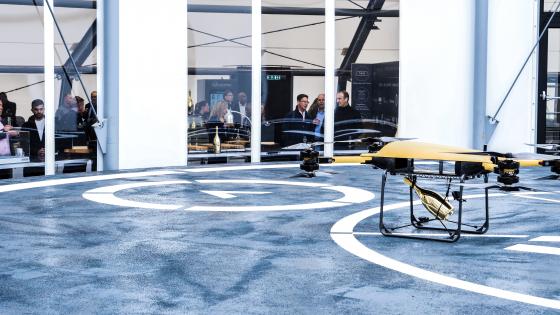
The next prototype will incorporate findings from the Coventry installation
Prototypes and test facilities for UAM solutions are also providing vital learnings. Urban-Air Port last year conducted a month-long demonstration of its Air-One hub for eVTOL air taxis and autonomous delivery drones in the centre of UK city Coventry in conjunction with Hyundai Motor Group’s AAM division Supernal. Urban-Air Port has ambitions to establish more than 200 vertiports worldwide over the next five years.
The 17,000 sq ft radial Air-One, which is designed for rapid assembly and disassembly, included a cargo logistics hub. It demonstrated aircraft command and control, eVTOL charging, and cargo loading for unmanned drones. Around 150 demonstration VLOS flights using a variety of drones were conducted, including Malloy Aeronautics T-150 70kg payload vehicle and Skyfarer’s logistics drone, said Darryn Holder, head of planning and partnerships.
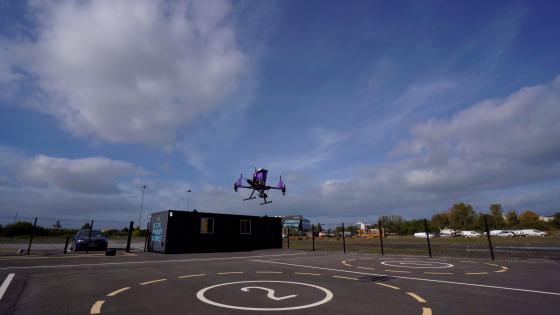
Learnings from FMCI’s drone activities will be fed into its new vertiport at Shannon Airport
Drone logistics are paving the way for passenger VTOL operations, said Holder, demonstrating safe operation in the airspace. “Flight operations, ground infrastructure and supporting systems and processes can also be tested and demonstrated. This is particularly relevant for Urban-Air Port’s vertiport infrastructure, which serves both logistic and passenger use cases,” he explained. “The commercial use cases for drone logistics can be realised earlier than for passenger services and these offer an opportunity for the AAM industry to sustain itself until passenger use cases are established. Diversification and maximising capacity utilisation will ultimately see both passenger and logistics services integrated into vertiport commercial operations,” he added.
Learning from experience
Urban-Air Port is currently developing a new prototype that incorporates lessons learned from the Coventry installation along with: regulatory guidance; resilience, high-throughput and high turnaround capabilities; expanded charging infrastructure; and integrated aircraft maintenance and storage facilities. “Specifically for cargo, we have developed together with our logistics handling partners, goods handling capabilities incorporating automated processes with a high level of autonomy across a range of our vertiport products,” said Holder.
In Sweden, the company is working with Skelleftea Airport, the local municipality and Swedish construction and development group Skanska on integrating drone deliveries at a new logistics site. Holder said the Skellefteå Hammarängen Droneport feasibility study was completed at the end of 2022 and is progressing to the next stage, which is to establish a prototype droneport by this autumn for testing and development of drones and supporting technologies. Commercial use cases will form part of subsequent stages, Holder confirmed.
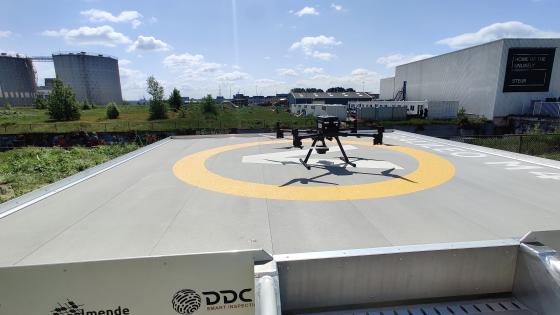
FMP offers everything from simple testing scenarios to multi-stakeholder innovation programmes
Future Mobility Campus Ireland (FMCI) is also working closely with an airport, Shannon Airport, on a vertiport project designed to integrate with airport operations. FMCI has been operating a Drone Port, which is just outside the airport boundary, for some years. The vertiport will be airside. “Our vertiport project will integrate with airport operations and provide a proof point of how vertiports can exist with airport services,” explained Russell Vickers, CEO. “Considerations such as passenger transit times, power requirements – we are expecting several megawatts to support charging infrastructure – and airspace management and integration are all under consideration as we build out,” he added.
In the meantime, it is gaining valuable learnings from its drone activities. It conducted the first cargo services in September 2021, demonstrating BVLOS in controlled airspace in a trial with FedEx and Skyports. FMCI is currently engaged in the European SESAR project, Enhanced Automation for U-Space/ATM integration (EALU-AER) in conjunction with Collins Aerospace, AvTrain, Deepblue, IAA, Manna and the Shannon Airport Group. EALU-AER is one of three Digital Sky Demonstrator projects across Europe designed to support the roll out of digital airspace management as the continent scales up drone operations and then air taxi services.
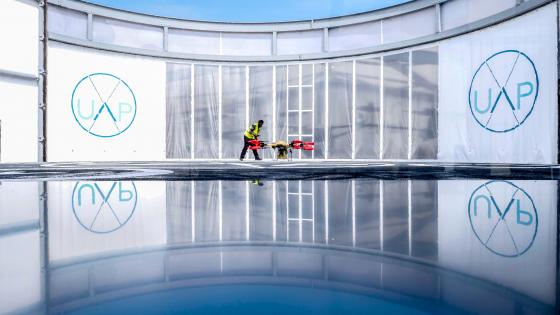
The 17,000 sq ft radial Air-One, designed for rapid assembly and disassembly, includes a cargo logistics hub
“Our Drone Port is very important as a demonstrator to both the regulator and industry on best practice and the possibilities that drone services can offer,” said Vickers. “We are currently undergoing a design study to integrate an airside vertiport at Shannon Airport to enable air taxi services for both eVTOL and eCTOL for both cargo and passengers,” he added. The aim is to offer air taxi services from Shannon Airport for golf’s 2027 Ryder Cup, which will take place at Adare Manor, County Limerick. “We feel that Ireland, particularly the west coast, is well suited to air taxi and drone operations as the existing transport infrastructure means generally long travel times for even short distances,” said Vickers.
In the Netherlands, the Future Mobility Park (FMP) is initially focusing on cargo drones, but the test facility has far-reaching ambitions (see ‘From theory to practice’).

“FMP functions as an extensive testbed for a wide range of drone services, extending beyond the transport of cargo and passengers. In the future, all sorts of drones will populate the skies and our objective is to create a vertiport that can accommodate the diverse needs of these drones, whether they are involved in cargo operations, passenger transport or other services,” explained director Lucien Linders.
“Our facilities at FMP offer a unique opportunity to actively contribute to the advancement of passenger mobility and the development of vertiports,” he explained. “By serving as a concrete platform for exploring and showcasing the practical aspects of urban air mobility, we can shape the optimal design and functionality of vertiports, ensuring a seamless experience for all stakeholders,” said Linders, pointing to trialling and refining safety, efficiency and logistical processes.
Linders said facilities such as FMP are playing an important role in fostering meaningful engagement with regulators, industry stakeholders and the public.
He added: “Our facility at FMP not only serves as a practical testing ground, but also acts as a catalyst for progress. It empowers us to pave the way for passenger mobility advancements, refine vertiport functionalities and gather vital insights to enhance the overall UAM landscape.”
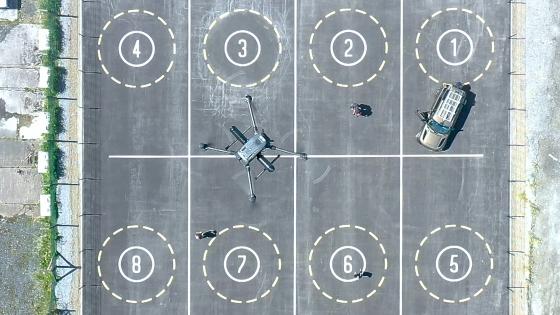
FMCI has operated a drone port next to Shannon Airport for several years
Further reading: FMP, from theory to practice
The Future Mobility Park (FMP) in Rotterdam, the Netherlands, has been established by the Future Mobility Network (FMN) as a testing ground for innovative mobility solutions, including autonomous vehicles and smart infrastructure. The park features state-of-the-art facilities for research, testing and collaboration among industry, governments and universities, with the aim of accelerating the development and adoption of sustainable transportation solutions and fostering a more connected and efficient urban environment.
One of its major aims is to explore the use of drones within city environments, said Lucien Linders, FMP director, thereby bridging the gap between theoretical research and practical application.
Test flights were launched in late May, when a drone landed at the droneport, Galileo Stop M4H, for the first time in a collaborative project involving the FMN, Bayards Vertiports, the Port of Rotterdam, the municipality of Rotterdam, the Dutch Drone Company, the Province of South Holland and Almende. Galileo M4H is a fixed platform on which any drone can land. It is testing drone link development, combining controlled airspace surrounding an airport, an industrial port region and the urban area around a major European city. A similar vertiport is located at the RDM shipyard on the other side of the Nieuwe Maas distributary, with future plans for drone flights between the two in a complex city-airport-port environment.
“We have exciting plans for conducting further tests in the near future,” said Robin Provilij, FMN drone specialist. “The vertiport at our facility can be reserved by drone service providers and will soon offer the capability to charge any drone that lands on it.” He foresees a future of a network of fixed and mobile vertiports incorporating charging facilities and part of a reservation platform.
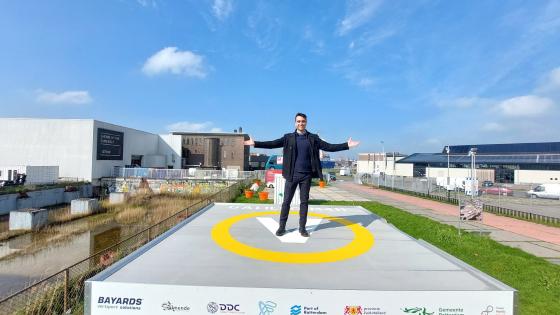
FMP serves as a platform for exploring and showcasing the practical aspects of urban air mobility
